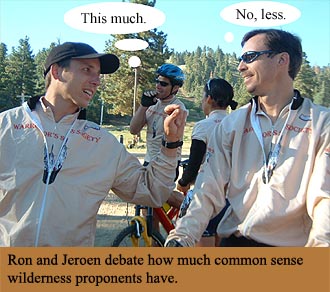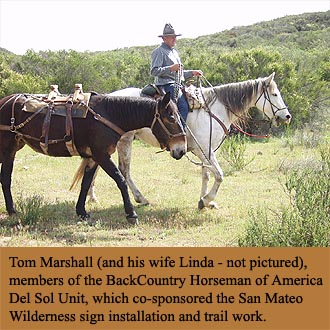Contents
Opening page
Editorial Staff
Introduction
Club and General News
Warrior's Racing
Access Updates
Featured Stories:
Triumph and Tragedy on
Liberty Ridge
Why I Love Mountain Biking
Between Spring Rains
The Biscuit Fire
All in a Day's Ride
Guest Commentary
Nature vs. Politics:
Greenpeace is Wrong
to Oppose Logging.
Commentary
The Price of Freedom
Closing Thoughts


|
Guest Commentary
Nature vs. Politics: Greenpeace is Wrong to Oppose Logging.
By Dr. Patrick Moore
Greenpeace has just issued a report claiming that it is better to let our forests burn to the ground than to adopt
programs that will reduce catastrophic wildfire. As an ecologist, I can tell you that this approach ultimately
leads to soil destruction, air and water pollution, and wildfires that can kill every living thing in our
forests-all in the name of "saving the forests."
 Having dedicated my life to the environment, I am always concerned when the forces of nature meet face-to-face
with the forces of politics. This is especially true when the forces of nature are coming in loud and clear:
Approximately 90 million acres of our nation's public forests are at risk of catastrophic wildfire right now.
Every year we see millions of acres of forest burn when this could be prevented.
Having dedicated my life to the environment, I am always concerned when the forces of nature meet face-to-face
with the forces of politics. This is especially true when the forces of nature are coming in loud and clear:
Approximately 90 million acres of our nation's public forests are at risk of catastrophic wildfire right now.
Every year we see millions of acres of forest burn when this could be prevented.
At the Western Governors' Association summit this week in Missoula, Montana, the topic will be forest health.
Earlier this month the House passed a bill that would hopefully improve forest officials' ability to properly
manage the forests. The Senate is scheduled to begin hearings on this bill next week.
We live in an era when many activists believe we should leave our forests alone-an ecologically dangerous policy
that sets our forests up to be destroyed not just by fire but by insects and disease. It is especially bewildering
when you consider how simple it is, through the application of time-tested forest management practices, to
maintain forests in a state that reduces the chance of such outcomes.
The root of the problem is that when we protect our forests from wildfires, over time they become susceptible to
disease and to catastrophic wildfires as fuel loads build up. The only way to prevent this is to actively remove
dead trees and to thin the forest. The active management of these forests is necessary to protect human life and
property, along with air, water and wildlife. This does not prevent us from also maintaining a world-class system
of parks and wilderness areas where industrial activity is restricted or banned.
 Many activists have a mindset that is simply opposed to forestry. These groups favor policies that involve
reducing the use of wood instead of encouraging its use as a renewable resource. We have been led to believe that
when we use wood we are causing a bit of forest to be lost. This is not the case. When we buy wood we send a
signal into the marketplace to plant more trees and produce more wood. One of the main reasons there is still
about the same area of forested land in the U.S. today as there was 100 years ago is because we use so much wood.
Agriculture and urbanization cause forest loss, not forestry.
Many activists have a mindset that is simply opposed to forestry. These groups favor policies that involve
reducing the use of wood instead of encouraging its use as a renewable resource. We have been led to believe that
when we use wood we are causing a bit of forest to be lost. This is not the case. When we buy wood we send a
signal into the marketplace to plant more trees and produce more wood. One of the main reasons there is still
about the same area of forested land in the U.S. today as there was 100 years ago is because we use so much wood.
Agriculture and urbanization cause forest loss, not forestry.
The inferno that began in the Bandelier National Monument near Los Alamos, NM, in May 2000 is a classic case in
point. The park officials who started this fire did so with good intentions. But they failed to take into account
that more than 50 years of fire prevention had resulted in a fuel load buildup that nearly guaranteed what ensued:
hundreds of homes destroyed and thousands of acres of forest lost.
The only solution in these circumstances is removal of wood to reduce the fuel load. In some types of forests, it
may be possible to manage fuel loads with prescribed fire. In other forest types, especially where there are homes
and other property at risk, mechanical thinning and harvesting are the best options.
It is unfortunate that some organizations characterize the need to implement active management of national forests
as damaging to the environment. It is actually the only way to break the present environmentally destructive
pattern of fuel buildup that often results in catastrophic outcomes. I hope that those responsible for our forests
will bring about the very necessary changes in law and practice-and return the forces of nature to a more
desirable state.
Dr. Moore is co-founder and former president of Greenpeace. His web site is
www.greenspirit.com
In accordance with Title 17 U.S.C. Section 107, any copyrighted work in this message is distributed
under fair use without profit or payment for non-profit research and educational purposes only. [Ref.
http://www.law.cornell.edu/uscode/17/107.shtml]
|
"We shall not be poor if we love liberty, because the nation that loves
liberty truly sets every man free to do his best and be his best."
Woodrow Wilson
Commentary
The Price of Freedom
By Candace Ricks-Oathout
Today I saw the price of freedom to use public lands. It is a price that very few were willing to pay. As Tom
Jefferson once said, "The price of freedom is eternal vigilance." Today is April 14, 2003, the day the Forest
Service presented the Wasatch-Cache National Forest Revised Plan in the first of a series of open house meetings.
Forest Service employees have spent a little over four years and waded through over 3,700 written comments and
numerous individual discussions on how the plan should be revised. According to Tom Tidwell, the Forest
Supervisor, "This revision will not satisfy everyone and I expect nobody will be pleased with all of it." Over
3,700 people took the time to comment on the Revised Plan, while a number of those comments were mass formatted
e-mails or postcards, there were an unusually high number of carefully written letters from individuals. These
comments were influential in assisting the planners to develop an additional alternative to the six submitted for
review, and alternative seven was chosen as the best revision to the plan. So how many people were in attendance
 to see this alternative revealed, review the maps and question the Forest Service employees who had worked so hard
to produce it? Three-a reporter from the Salt Lake City Tribune, a young man who enjoys backcountry skiing and me.
Where were the representatives of the any of the multiple use groups? Where, in fact, were members of the
environmental industry? The Forest Service employees have a monthly breakfast with interested parties. I plan to
attend the next one.
to see this alternative revealed, review the maps and question the Forest Service employees who had worked so hard
to produce it? Three-a reporter from the Salt Lake City Tribune, a young man who enjoys backcountry skiing and me.
Where were the representatives of the any of the multiple use groups? Where, in fact, were members of the
environmental industry? The Forest Service employees have a monthly breakfast with interested parties. I plan to
attend the next one.
What did I accomplish by attending this open house? I learned about the monthly breakfast meeting that often
gathers valuable preliminary data that will lead to the development of various site-specific plans, including
trails and routes of travel. I spoke with the Forest Service's wildlife biologist who will be sending me maps and
statistical data on potential lynx habitat, wolf migration and white-tailed deer migration. I also learned a lot
about how indicator species are chosen and how the species chosen influence forest management. I learned about the
Regional Advisory Committee meetings, when they are held and how to look up the meeting agendas in order to attend
and provide appropriate public comment. I learned the reason that we have so many problems with public lands
access. We are not paying the price of maintaining that access. I know how hard it is to make the time to attend
these meetings and to write to our elected officials and tell them how important keeping our access is. I know we
would rather be out recreating in the forest than sitting in a conference room listening to a PowerPoint
presentation. I know we have to earn a living and pay for the livestock or toys we use in our recreation, but we
also have to pay the price of freedom for our recreational access. We have to get involved in the process and stay
engaged in it. The point behind a recent Multiple Use Summit was to develop a strong united coalition to lobby for
our individual rights to recreate on public lands. We need members of that coalition to attend planning meetings
and open houses to stay informed, stay engaged and befriend those Forest Service employees who will be making the
next round of decisions that affect our rights to public access. We must pay the price of freedom by being
eternally vigilant.
Candace Ricks-Oathout
Chair, Citizens Against Recreational Eviction
Utah Representative, Warrior's Society
Utah Representative, Americans for Forest Access
Member, Backcountry Horsemen of California, Caballeros del Sol Unit
Member, Tijuana River Valley Equestrian Association
|
|
